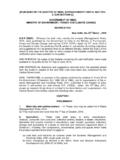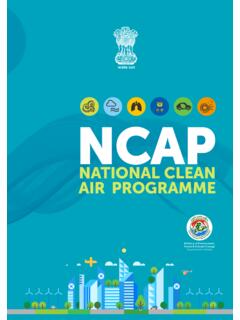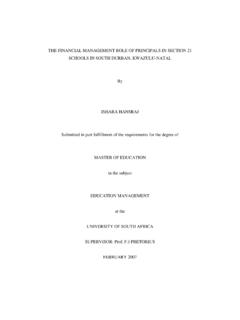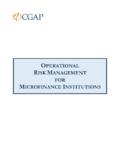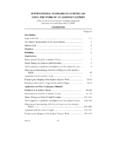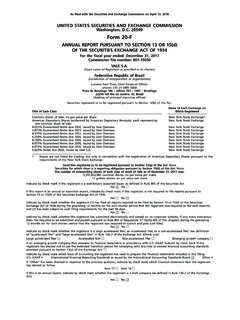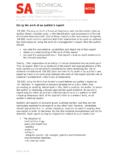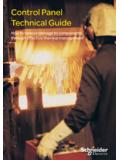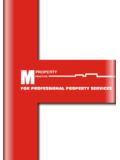Transcription of STANDARD TERMS OF REFERENCE [TOR] FOR EIA / …
1 STANDARD TERMS OF REFERENCE [TOR] FOREIA / EMP REPORT FOR PROJECTS / activities requiring environment clearance under EIA NOTIFICATION, 2006 INDEXSTANDARD TERMS OF REFERENCE (TOR) FOR EIA/EMP REPORT FORPROJECTS / activities requiring environment of the STANDARD TERMS of REFERENCE (TOR) summary of the EIA/EMP Report17 project or Activity as per Schedule of the EIA Notification, 2006 Chapter (a)Mining of minerals (non-coal and coal mining sectors) (b)Offshore and onshore oil and gas exploration, development & (c)River Valley (d)Thermal Power (e)Nuclear power projects and processing of nuclear fuel72 Chapter (a)Coal (b)Mineral beneficiation88 Chapter (a)Metallurgical industries (ferrous & non-ferrous) (b)Cement plants102 Chapter (a)Petroleum refining (b)Coke oven (c )Asbestos milling and asbestos based (d)Chlor-alkali (e)Soda ash (f)Leather/skin/hide processing industry142 Chapter (a)Chemical (b)Pesticides industry and pesticide specific intermediates (excluding157formulations) (c)Petro-chemical complexes (industries based on processing of163petroleum fractions & natural gas and/or reforming to aromatics) (d)Manmade fibres (e)Petrochemical based processing (processes other than cracking &175reformation and not covered under the complexes) (f)Synthetic organic chemicals industry (dyes & dye intermediates;181bulk drugs and intermediates excluding drug formulations; syntheticrubbers.)
2 Basic organic chemicals, other synthetic organic chemicalsand chemical intermediates) (g) (h)Integrated paint (i)Pulp & paper industry excluding manufacturing of paper from waste200paper and manufacture of paper from ready pulp with out (j)Sugar (k)Induction/arc furnaces/cupola furnaces 5 TPH or more212 Chapter (a)Oil & gas transportation pipe line (crude and refinery/petrochemical221products), passing through national parks / sanctuaries / coral reefs /ecologically sensitive areas including LNG (b)Isolated storage & handling of hazardous chemicals (As per threshold223planning quantity indicated in column 3 of schedule 2 & 3 of MSIHCR ules 1989 amended 2000)Chapter (a)Air (b)All ship breaking yards including ship breaking (c)Industrial estates/ parks/ complexes/ areas, export processing Zones235(EPZs), Special Economic Zones (SEZs), Biotech Parks, (d)Common hazardous waste treatment, storage and disposal facilities238(TSDFs) (e)Ports, (f) (g)Aerial (h)Common Effluent Treatment Plants (CETPs) (i)Common Municipal Solid Waste Management Facility (CMSWMF)249 Chapter 8251-254418(b)Townships and Area Development TERMS OF REFERENCE (TOR) FOR EIA/EMP REPORT FORPROJECTS/ activities requiring environment CLEARANCEO bjective of the STANDARD TERMS of REFERENCE (TOR)The Environmental clearance under the Environmental Impact Assessment (EIA)Notification, 2006 is a process which comprises of four stages viz.
3 Stage (1) Screening(Only for Category 'B' projects and activities ); Stage (2) Scoping; Stage (3) PublicConsultation; and Stage (4) TERMS of REFERENCE is prescribed for project seeking Environmental clearance (EC) under the provision of the environment Impact Assessment Notification, 2006 (exceptfor project under item No. 8-a). The TERMS of REFERENCE issued after approval of theMinistry/SEIAA is based on the recommendation of the Expert Appraisal Committee (EAC)/ State Expert Appraisal Committee (SEAC). There has been persistent demand of theindustry and user agencies that the TOR for all the sectors requiring EC should bestandardized as determining TOR for every case individually is time consuming and standardization of TOR is a major step forward in rationalizing theprocess of Environmental Clearances.
4 This will reduce delays, removearbitrariness and make the system transparent. The STANDARD TOR have beendeveloped by the help of inputs from experts and have been recommended by theEACs of the respective sectors. Standardization of the TOR will enable the ProjectProponent to commence the EIA study after successful online registration. TheEAC/SEAC will have the right and the responsibility of stipulating additional TORin specific Projects considering its project features within 30 days of the onlineregistration of the proposals. All the proposals would have to be placed by theconcerned Member Secretary before the EAC/SEAC in the first meetingimmediately on registration. This procedure would apply to all proposals pendingfor TOR and the 30 days would commence from the day the STANDARD TOR STANDARD TERMS of REFERENCE has been prepared for guiding the ProjectProponent on preparation of EIA / EMP Report and expediting the process ofEnvironmental clearance without compromising environmental norms and therigor of environment impact assessment.
5 **2 STANDARD TERMS OF REFERENCE (TOR) FOR EIA/EMP REPORT FOR PROJECTS/ activities requiring environment CLEARANCEINTRODUCTIONCONCEPTUAL FACETS OF environment IMPACT ASSESSMENTThe Ministry of environment , Forest and Climate Change has notified the Environmental ImpactAssessment (EIA) Notification, 2006 under the provisions of the environment (Protection) Act, 1986,which regulates development and their expansion/modernization of 39 sectors/ activities listed in theSchedule to the EIA Notification, 2006. There are two Category of the projects viz. Category 'A' projectsare handled at the level of MoEF&CC and the Category 'B' projects are handled by the respective StateEnvironment Impact Assessment Authority (SEIAA) following the procedure prescribed under the EIAN otification, per "General Condition" under the EIA notification, 2006, "Any project or activity specified inCategory 'B' is treated as Category 'A', if located in whole or in part within 5 km from the boundary of: (i)Protected Areas notified under the Wild Life (Protection) Act, 1972, (ii) Critically Polluted areas as notifiedby the Central Pollution Control Board from time to time, (iii) Notified Eco-sensitive areas, (iv) inter-Stateboundaries and international boundaries".
6 It is an imperative requirement to understand the basic concepts concerned to the pollution controland the environmental impact assessment in an overall objective of the sustainable in EIA Context" environment " in EIA context mainly focuses, but is not limited to physical, chemical, biological,geological, social, economical, and aesthetic dimensions along with their complex interactions, whichaffects individuals, communities and ultimately determines their forms, character, relationship, and EIA context, 'effect' and 'impact' can often be used interchangeably. However, 'impact' is considered asa value judgment of the significance of an development is built on three basic premises , economic growth, ecological balanceand social progress. Economic growth achieved in a way that does not consider, the environmental concerns,will not sustain in the long run.
7 Therefore, sustainable development needs careful integration ofenvironmental, economic, and social needs in order to achieve both an increased STANDARD of living inshort term, and a net gain or equilibrium among human, natural, and economic resources to support futuregenerations in the long term. It is necessary to understand the links between environment and developmentin order to make choices for development that will be economically efficient, socially equitable andresponsible, as well as environmentally Control StrategiesPollution control strategies can be broadly categorized into preventive and reactive. The reactivestrategy refers to the steps that may be applied once the wastes are generated or contamination of thereceiving environment takes place.
8 The control technology or a combination of technologies to minimize theimpact due to process rejects/wastes varies with quantity and characteristics desired control efficiency and3 STANDARD TERMS OF REFERENCE (TOR) FOR EIA/EMP REPORT FORPROJECTS/ activities requiring environment clearance economics. Many combinations of techniques could be adopted for treatment of a specific waste or thecontaminant receiving environment , but are often judged based on techno-economic feasibility. Therefore,the best alternative is to take all possible steps to avoid pollution itself. This preventive approach refers toa hierarchy that involves: i) prevention & reduction; ii) recycling and re-use; iii) treatment; and iv) disposal, , there is a need to shift the emphasis from the reactive to preventive strategy , topromote preventive environmental management.
9 Preventive environmental management tools may begrouped into management based tools, process based tools and product based for Preventive Environmental ManagementThe tools for preventive environmental management can be broadly classified into followingtwo groups (i) Tools for assessment and analysis - risk assessment, life cycle assessment, total costassessment, environmental audit / statement, environmental benchmarking, environmental indicators. (ii)Tools for action - environmental policy, market based economic instruments, innovative funding mechanism,EMS and ISO certification, total environmental quality movement, eco-labeling, cleaner production, eco-efficiency, industrial ecosystem or metabolism, voluntary agreements.(i)Tools for assessment and analysis:Risk assessment: Risk is associated with the frequency of failure and consequence effect.
10 Predictingsuch situations and evaluation of risk is essential to take appropriate preventive measures. The majorconcern of the assessment is to identify the activities falling in a matrix of high & low frequencies at 4 STANDARD TERMS OF REFERENCE (TOR) FOR EIA/EMP REPORT FOR PROJECTS/ activities requiring environment clearance which the failures occur and the degree of its impact. The high frequency, low impact activities can bemanaged by regular maintenance , Leak detection and repair (LDAR) programmes. Whereas, the lowfrequency, high impact activities (accidents) are of major concern in TERMS of risk assessment. As thefrequency is low, often the required precautions are not realized or maintained. However, the risk assessmentidentifies the areas of major concerns which require additional preventive measures, likely consequencedistances considering domino effects, which will give the possible casualties and ecological loss in case ofaccidents.

